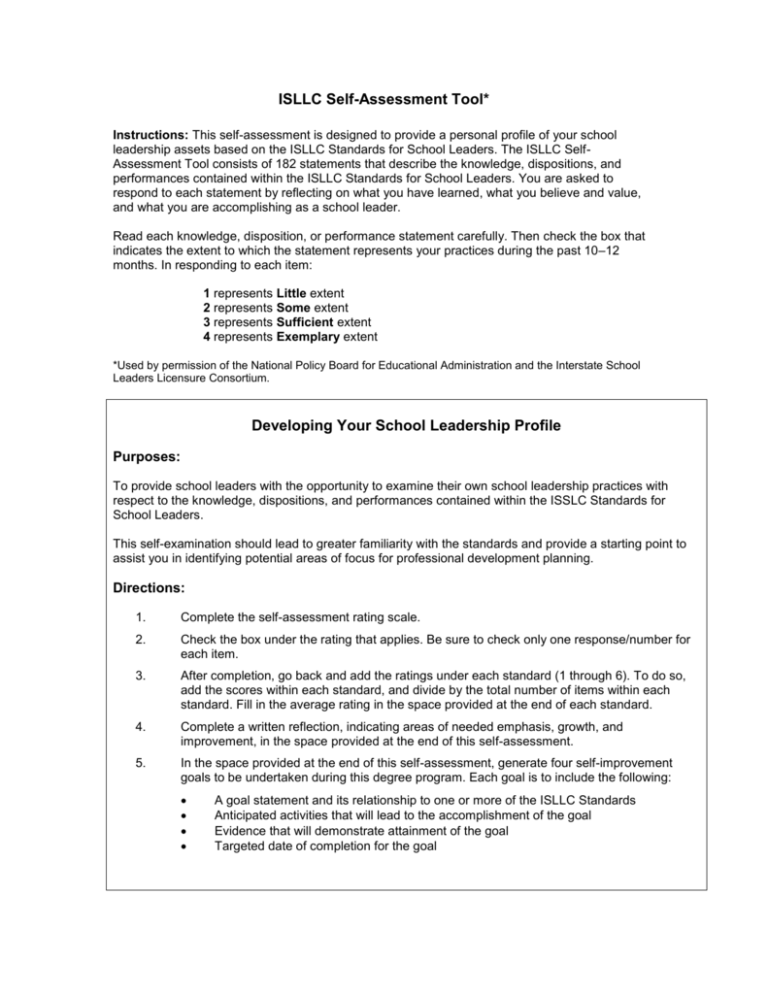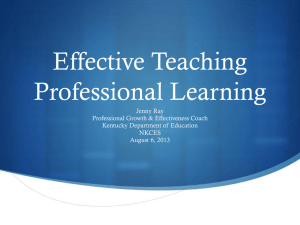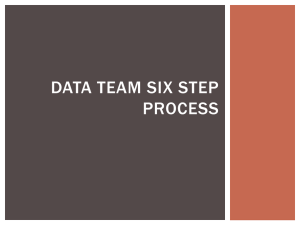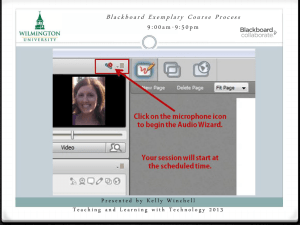ISLLC Self-Assessment Tool
advertisement

ISLLC Self-Assessment Tool* Instructions: This self-assessment is designed to provide a personal profile of your school leadership assets based on the ISLLC Standards for School Leaders. The ISLLC SelfAssessment Tool consists of 182 statements that describe the knowledge, dispositions, and performances contained within the ISLLC Standards for School Leaders. You are asked to respond to each statement by reflecting on what you have learned, what you believe and value, and what you are accomplishing as a school leader. Read each knowledge, disposition, or performance statement carefully. Then check the box that indicates the extent to which the statement represents your practices during the past 10–12 months. In responding to each item: 1 represents Little extent 2 represents Some extent 3 represents Sufficient extent 4 represents Exemplary extent *Used by permission of the National Policy Board for Educational Administration and the Interstate School Leaders Licensure Consortium. Developing Your School Leadership Profile Purposes: To provide school leaders with the opportunity to examine their own school leadership practices with respect to the knowledge, dispositions, and performances contained within the ISSLC Standards for School Leaders. This self-examination should lead to greater familiarity with the standards and provide a starting point to assist you in identifying potential areas of focus for professional development planning. Directions: 1. Complete the self-assessment rating scale. 2. Check the box under the rating that applies. Be sure to check only one response/number for each item. 3. After completion, go back and add the ratings under each standard (1 through 6). To do so, add the scores within each standard, and divide by the total number of items within each standard. Fill in the average rating in the space provided at the end of each standard. 4. Complete a written reflection, indicating areas of needed emphasis, growth, and improvement, in the space provided at the end of this self-assessment. 5. In the space provided at the end of this self-assessment, generate four self-improvement goals to be undertaken during this degree program. Each goal is to include the following: A goal statement and its relationship to one or more of the ISLLC Standards Anticipated activities that will lead to the accomplishment of the goal Evidence that will demonstrate attainment of the goal Targeted date of completion for the goal Standard 1: A school administrator is an educational leader who promotes the success of all students by facilitating the development, articulation, implementation, and stewardship of a vision of learning that is shared and supported by the school community. To what extent do I have a CURRENT PERSONAL MASTERY of the following Knowledge indicators? LITTLE (1) learning goals in a pluralistic society the principles of developing and implementing strategic plans systems theory information sources, data collection, and data analysis strategies effective communication effective consensus-building and negotiation skills SOME (2) SUFFICIENT (3) EXEMPLARY (4) To what extent do I have a CURRENT PERSONAL BELIEF IN, VALUE OF, AND COMMITMENT to the following Disposition indicators? LITTLE (1) the educability of all a school vision of high standards of learning continuous school improvement the inclusion of all members of the school community ensuring that students have the knowledge, skills, and values needed to become successful adults a willingness to continuously examine one’s own assumptions, beliefs, and practices doing the work required for high levels of personal and organization performance SOME (2) SUFFICIENT (3) EXEMPLARY (4) 2 To what extent do I CURRENTLY FACILITATE PROCESSES AND ENGAGE IN ACTIVITIES ensuring the following Performance indicators? LITTLE (1) the vision and mission of the school are effectively communicated to staff, parents, students, and community members the vision and mission are communicated through the use of symbols, ceremonies, stories, and similar activities the core beliefs of the school vision are modeled for all stakeholders the vision is developed with and among stakeholders the contributions of school community members to the realization of the vision are recognized and celebrated progress toward the vision and mission is communicated to all stakeholders the school community is involved in school improvement efforts the vision shapes the educational programs, plans, and actions an implementation plan is developed in which objectives and strategies to achieve the vision and goals are clearly articulated assessment data related to student learning are used to develop the school vision and goals relevant demographic data pertaining to students and their families are used in developing the school mission and goals barriers to achieving the vision are identified, clarified, and addressed needed resources are sought and obtained to support the implementation of the school mission and goals existing resources are used in support of the SOME (2) SUFFICIENT (3) EXEMPLARY (4) 3 school vision and goals the vision, mission, and implementation plans are regularly monitored, evaluated, and revised Standard 1: Average = Total ÷ 28 Average = Standard 2: A school administrator is an educational leader who promotes the success of all students by advocating, nurturing, and sustaining a school culture and instructional program conducive to student learning and staff professional growth. To what extent do I have a CURRENT PERSONAL MASTERY of the following Knowledge indicators? LITTLE (1) student growth and development applied learning theories applied motivational theories curriculum design, implementation, evaluation, and refinement principles of effective instruction measurement, evaluation, and assessment strategies diversity and its meaning for educational programs adult learning and professional development models the change process for systems, organizations, and individuals the role of technology in promoting student learning and professional growth school cultures SOME (2) SUFFICIENT (3) EXEMPLARY (4) 4 To what extent do I have a CURRENT PERSONAL BELIEF IN, VALUE OF, AND COMMITMENT to the following Disposition indicators? LITTLE (1) student learning as the fundamental purpose of schooling the proposition that all students can learn the variety of ways in which students can learn life-long learning for self and others professional development as an integral part of school improvement the benefits that diversity brings to the school community a safe and supportive learning environment preparing students to be contributing members of society SOME (2) SUFFICIENT (3) EXEMPLARY (4) To what extent do I CURRENTLY FACILITATE PROCESSES AND ENGAGE IN ACTIVITIES ensuring the following Performance indicators? LITTLE (1) all individuals are treated with fairness, dignity, and respect professional development promotes a focus on student learning consistent with the school vision and goals students and staff feel valued and important the responsibilities and contributions of each individual are acknowledged barriers to student learning are identified, clarified, and addressed diversity is considered in developing learning experiences life-long learning is encouraged and modeled there is a culture of high expectations for self, SOME (2) SUFFICIENT (3) EXEMPLARY (4) 5 student, and staff performance technologies are used in teaching and learning student and staff accomplishments are recognized and celebrated multiple opportunities to learn are available to all students the school is organized and aligned for success curricular, co-curricular, and extra-curricular programs are designed, implemented, evaluated, and refined curriculum decisions are based on research, expertise of teachers, and the recommendations of learned societies the school culture and climate are assessed on a regular basis a variety of sources of information is used to make decisions student learning is assessed using a variety of techniques multiple sources of information regarding performance are used by staff and students a variety of supervisory and evaluation models is employed pupil personnel programs are developed to meet the needs of students and their families Standard 2: Average = Total ÷ 39 Average = Standard 3: A school administrator is an educational leader who promotes the success of all students by ensuring management of the organization, operations, and resources for a safe, efficient, and effective learning environment. To what extent do I have a CURRENT PERSONAL MASTERY of the following Knowledge indicators? 6 LITTLE (1) theories and models of organizations and the principles of organizational development operational procedures at the school and district level principles and issues relating to school safety and security human resources management and development principles and issues relating to fiscal operations of school management principles and issues relating to school facilities and use of space legal issues impacting school operations current technologies that support management functions SOME (2) SUFFICIENT (3) EXEMPLARY (4) To what extent do I have a CURRENT PERSONAL BELIEF IN, VALUE OF, AND COMMITMENT to the following Disposition indicators? LITTLE (1) making management decisions to enhance learning and teaching taking risks to improve schools trusting people and their judgment accepting responsibility having high-quality standards, expectations and performances involving stakeholders in management processes promoting a safe environment SOME (2) SUFFICIENT (3) EXEMPLARY (4) 7 To what extent do I CURRENTLY FACILITATE PROCESSES AND ENGAGE IN ACTIVITIES ensuring the following Performance indicators? LITTLE (1) knowledge of learning, teaching, and student development is used to form management decisions operational procedures are designed and managed to maximize opportunities for successful learning emerging trends are recognized, studied, and applied as appropriate operational plans and procedures to achieve the vision and goals of the school are in place collective bargaining and other contractual agreements related to the school are effectively managed the school plant, equipment, and support systems operate safely, efficiently, and effectively time is managed to maximize attainment of organizational goals potential problems and opportunities are identified problems are confronted and resolved in a timely manner financial, human, and material resources are aligned to the goals of the school the school acts entrepreneurially to support continuous improvement organizational systems are regularly monitored and modified as needed stakeholders are involved in decisions affecting the school responsibility is shared to maximize ownership and accountability effective problem-framing and problem-solving skills are used SOME (2) SUFFICIENT (3) EXEMPLARY (4) 8 effective conflict resolution skills are used effective group-process and consensusbuilding skills are used effective communication skills are used there is effective use of technology to manage school operations fiscal resources of the school are managed responsibly, efficiently, and effectively a safe, clean, and aesthetically pleasing school environment is created and maintained human resource functions support the attainment of school goals confidentiality and privacy of school records are maintained Standard 3: Average = Total ÷ 38 Average = Standard 4: A school administrator is an educational leader who promotes the success of all students by collaborating with families and community members, responding to diverse community interests and needs, and mobilizing community resources. To what extent do I have a CURRENT PERSONAL MASTERY of the following Knowledge indicators? LITTLE (1) emerging issues and trends that potentially impact the school community the conditions and dynamics of the diverse school community community resources community relations and marketing strategies and processes successful models of school, family, business, community, government and higher education partnerships SOME (2) SUFFICIENT (3) EXEMPLARY (4) 9 To what extent do I have a CURRENT PERSONAL BELIEF IN, VALUE OF, AND COMMITMENT to the following Disposition indicators? LITTLE (1) schools operating as an integral part of the larger community collaboration and communication with families involvement of families and other stakeholders in school decision-making processes the proposition that diversity enriches the school families as partners in the education of their children the proposition that families have the best interests of their children in mind resources of the family and community needing to be brought to bear on the education of students an informed public SOME (2) SUFFICIENT (3) EXEMPLARY (4) To what extent do I CURRENTLY FACILITATE PROCESSES AND ENGAGE IN ACTIVITIES ensuring the following Performance indicators? LITTLE (1) high visibility, active involvement, and communication with the larger community is a priority relationships with community leaders are identified and nurtured information about family and community concerns, expectations, and needs is used regularly there is outreach to different business, religious, political, and service agencies and organizations credence is given to individuals and groups SOME (2) SUFFICIENT (3) EXEMPLARY (4) 10 whose values and opinions may conflict the school and community serve one another as resources available community resources are secured to help the school solve problems and achieve goals partnerships are established with area business, institutions of higher education, and community groups to strengthen programs and support school goals community youth family services are integrated with school programs community stakeholders are treated equitably diversity is recognized and valued effective media relations are developed and maintained a comprehensive program of community relations is established public resources and funds are used appropriately and wisely community collaboration is modeled for staff opportunities for staff to develop collaborative skills are provided Standard 4: Average = Total ÷ 29 Average = 3 Standard 5: A school administrator is an educational leader who promotes the success of all students by acting with integrity, fairness, and in an ethical manner. To what extent do I have a CURRENT PERSONAL MASTERY of the following Knowledge indicators? LITTLE (1) SOME (2) SUFFICIENT (3) EXEMPLARY (4) the purpose of education and the role of leadership in modern society 11 various ethical frameworks and perspectives on ethics the values of the diverse school community professional codes of ethics the philosophy and history of education To what extent do I have a CURRENT PERSONAL BELIEF IN, VALUE OF, AND COMMITMENT to the following Disposition indicators? LITTLE (1) the ideal of the common good the principles in the Bill of Rights the right of every student to a free, quality education bringing ethical principles to the decisionmaking process subordinating one’s own interests for the good of the school community accepting the consequences for upholding one’s principles and actions using the influence of one’s office constructively and productively in the service of all students and their families development of a caring school community SOME (2) SUFFICIENT (3) EXEMPLARY (4) To what extent do I CURRENTLY FACILITATE PROCESSES AND ENGAGE IN ACTIVITIES ensuring the following Performance indicators? LITTLE (1) examines personal and professional values demonstrates a personal and professional code of ethics SOME (2) SUFFICIENT (3) EXEMPLARY (4) 12 demonstrates values, beliefs, and attitudes that inspire others to higher levels of performance serves as a role model accepts responsibility for school operations considers the impact of one’s administrative practices on others uses the influence of the office to enhance the educational program rather than for personal gain treats people fairly, equitably, and with dignity and respect protects the rights and confidentiality of students and staff demonstrates appreciation for and sensitivity to the diversity in the school community recognizes and respects the legitimate authority of others examines and considers the prevailing values of the diverse school community expects that others in the school community will demonstrate integrity and exercise ethical behavior opens the school to public scrutiny fulfills legal and contractual obligations applies laws and procedures fairly, wisely, and considerately Standard 5: Average = Total ÷ 29 Average = Standard 6: A school administrator is an educational leader who promotes the success of all students by understanding, responding to, and influencing the larger political, social, economic, legal, and cultural context. To what extent do I have a CURRENT PERSONAL MASTERY of the following Knowledge indicators? LITTLE SOME SUFFICIENT EXEMPLARY 13 (1) principles of representative governance that undergird the system of American schools the role of public education in developing and renewing a democratic society and an economically productive nation the law as related to education and schooling the political, social, cultural, and economic systems and processes that impact schools models and strategies of change and conflict resolution as applied to the larger political, social, cultural, and economic contexts of schooling global issues and forces affecting teaching and learning the dynamics of policy development and advocacy under our democratic political system the importance of diversity and equity in a democratic society (2) (3) (4) SUFFICIENT (3) EXEMPLARY (4) To what extent do I have a CURRENT PERSONAL BELIEF IN, VALUE OF, AND COMMITMENT to the following Disposition indicators? LITTLE (1) seeing education as a key to opportunity and social mobility recognizing a variety of ideas, values, and cultures having a continuing dialogue with other decision makers affecting education actively participating in the political and policymaking context in the service of education using legal systems to protect student rights and improve student opportunities SOME (2) 14 To what extent do I CURRENTLY FACILITATE PROCESSES AND ENGAGE IN ACTIVITIES ensuring the following Performance indicators? LITTLE (1) the environment in which schools operate is influenced on behalf of students and their families communication occurs within the school community on trends, issues, and potential changes in the environment in which schools operate there is ongoing dialogue with representatives of diverse community groups the school community works within the framework of policies, laws, and regulations enacted by local, state, and federal authorities public policy is shaped to provide quality education for students lines of communication are developed with decision makers outside the school community SOME (2) Standard 6: Average = Total ÷ 19 SUFFICIENT (3) EXEMPLARY (4) Average = In the space below, please write your written reflection, indicating areas of needed emphasis, growth, and improvement (the space will expand as you type): In the space below, generate four self-improvement goals to be undertaken during this degree program. Each goal is to include the following: A goal statement and its relationship to one or more of the ISLLC Standards Anticipated activities that will lead to the accomplishment of the goal Evidence that will demonstrate attainment of the goal Targeted date of completion for the goal 15








